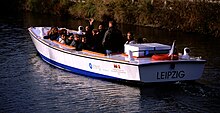Hydra (boat)
The Hydra was the world's first passenger boat that was powered by a fuel cell . A low-temperature fuel cell was used here. The boat, which is primarily used as a demonstration object, was approved for public transport in 1999.
history
The boat was built by the Bonn company etaing GmbH, which was founded in 1999 by Christian Machens and Harald Klein. The fuel cell came from ZeTec , which had been founded by Nicholas (Nick) Abson and which had set up a ZeMar department for this purpose . The ship itself was built by Ecoboot; the shipyard needed ten weeks for this.
The first trips took place in 1999 on the Karl-Heine Canal in Leipzig. The Hydra was approved by Germanischer Lloyd in Leipzig in 1999 for the public transport of 22 people and carried around 2,000 people in 1999/2000, including on canals in the Belgian city of Ghent . It was decommissioned in 2001. The cost of the entire project was around € 1 million.
The Hydra has proven for the first time that it is technologically possible to propel a passenger ship with fuel cells.
technical description
The hydra was 12 m long, 3 m wide and 0.52 m draft . It weighed around 4 t or 4.3 t with passengers. The propeller was powered by an 8 kW 48 V DC electric motor. The boat reached a nominal speed of six knots . The measured maximum speed was 15 km / h. The electric motor was supplied with electricity from an alkaline fuel cell (AFC Alkaline Fuel Cell). In addition, four accumulators with 55 Ah each were installed as intermediate storage and for rapid load changes . Back then, Hydra inventor and chief engineer Christian Machens chose an alkaline fuel cell (AFC) because it handles salty sea air better than PEM fuel cells. In addition, the fuel cell system could also start at temperatures below freezing point. The fuel used was hydrogen , which was in metal hydride storage in the bow. The metal hydride storage had a storage volume of 33 m³ hydrogen, which was sufficient for a two-day operation with eight hours of operation. Refueling took half an hour. The advantage of storing hydrogen in metal hydride storage tanks was the very compact storage and the possibility of preheating the fuel cell system with the waste heat from the metal hydride storage tank during refueling so that it could drive off at full power after refueling.
Web links
- Description of the boat on dieBrennstoffzelle.de: Fuel cell boat Hydra
- Video on YouTube about the first hydrogen boat World's first Fuel Cell Ship (Hydra, year 2000) german TV
- Video on YouTube World's first Fuel Cell Ship (Hydra, year 2000)
Individual evidence
- ↑ a b c d e Christian Merten: Fuel cell boat Hydra. In: Hydrogen Projects> Mobile Applications: History. dieBrennstoffzelle.de, accessed on April 15, 2018 .
- ^ A b c d e Kevin Desmond: Electric Boats and Ships: A History . McFarland & Co., Jefferson, North Carolina 2017, ISBN 978-1-4766-6515-3 , Seven 2000-2009, pp. 146–147 (English, limited preview in Google Book Search [accessed April 15, 2018]).
- ↑ Jim Motavalli: Forward Drive: The Race to Build the Clean Car of the Future . Routledge, Earthscan Publications Limited, London 2014, ISBN 1-85383-786-5 , Chapter 6: The Global Green Car: Europe on the Fast Track, pp. 148 (English, limited preview in Google Book Search [accessed April 15, 2018]).
- ↑ a b c d the passenger boat. etaing; www.hydrogencarsnow.com, accessed April 15, 2018 .

